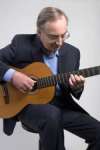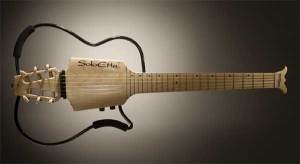 “Angels Of The Sun” by guitarist Fred Thrane (a Norwegian name pronounced “Trana”) is a multi-faceted offering that reflects various aspects of his musical persona. His six-string sojourn began when he started lessons at the age of 17 and he received a flash of inspiration upon hearing Andres Segovia playing Granados’ “Spanish Dance #5.” That style and sound became a beacon, which illuminated his way through many years of formal study culminating in a master’s degree in music with a specialty in classical guitar from Cal State University. In addition to his classroom studies, he also took private guitar lessons. As happens, the student becomes the teacher and Fred eventually became a Professor of Music at San Jose State University and Foothill College teaching classical guitar. Although he charted this course for seven years, a career detour led him in another direction and he took a fifteen-year sabbatical from music. This album heralds his return to playing, improvising, and composing and is his first CD release.
“Angels Of The Sun” by guitarist Fred Thrane (a Norwegian name pronounced “Trana”) is a multi-faceted offering that reflects various aspects of his musical persona. His six-string sojourn began when he started lessons at the age of 17 and he received a flash of inspiration upon hearing Andres Segovia playing Granados’ “Spanish Dance #5.” That style and sound became a beacon, which illuminated his way through many years of formal study culminating in a master’s degree in music with a specialty in classical guitar from Cal State University. In addition to his classroom studies, he also took private guitar lessons. As happens, the student becomes the teacher and Fred eventually became a Professor of Music at San Jose State University and Foothill College teaching classical guitar. Although he charted this course for seven years, a career detour led him in another direction and he took a fifteen-year sabbatical from music. This album heralds his return to playing, improvising, and composing and is his first CD release.
With regard to the aforementioned multi-faceted nature of Fred’s music, “Angels Of The Sun” showcases his playing style across various genres, most notably new age, classical, and flamenco –distinctly different styles. Given the diversity of his music, it is hard to give a generalized overview, so a more in-depth examination of individual songs is in order. The album opens with the title track, a new age style piece set to a mid-tempo beat accompanied by Dennis Murphy on bass and Jim Norris on percussion. This rhythm section is featured on almost all of the songs on the CD and adds nice support, enhancing and propelling the compositions. Worth mentioning is the distinctive tone that Fred gets from his steel string and nylon string SoloEtte guitars – very unconventional looking instruments, which can be seen in a photo that accompanies this review. Although he owns an expensive custom made classical guitar, Fred is most at home with these unique instruments, originally created as travel guitars, of which he has four. The tone is further augmented by the use of digital effects such as reverb, delay, and chorus.
 The next two songs on the album, “Big Sur” and “Dawndancer” continue in a jazzy ambient groove. However, as much as new age music is “my thing” personally, it is on some of the subsequent tracks with their Latin and flamenco influence, where I feel Fred really shines the most. As soon as “Fandango In Four” kicks in, he exhibits a command of the instrument and a take-charge attitude that felt assured and confident. The mood continues into the next track, “Farruca” with hand claps lending an air of authenticity and making it easy to envision a passionate flamenco dancer entranced by the beat. Following that is “Moraga Raga,” perhaps my favorite track on the album, with its breezy cruising down the road feel. I particularly liked how the song evolved into a more spacious mode in the later section. On the next song Fred steps into the solo spotlight on a beautiful Spanish-flavored classical guitar piece entitled “Soleares,”
The next two songs on the album, “Big Sur” and “Dawndancer” continue in a jazzy ambient groove. However, as much as new age music is “my thing” personally, it is on some of the subsequent tracks with their Latin and flamenco influence, where I feel Fred really shines the most. As soon as “Fandango In Four” kicks in, he exhibits a command of the instrument and a take-charge attitude that felt assured and confident. The mood continues into the next track, “Farruca” with hand claps lending an air of authenticity and making it easy to envision a passionate flamenco dancer entranced by the beat. Following that is “Moraga Raga,” perhaps my favorite track on the album, with its breezy cruising down the road feel. I particularly liked how the song evolved into a more spacious mode in the later section. On the next song Fred steps into the solo spotlight on a beautiful Spanish-flavored classical guitar piece entitled “Soleares,”
The next to the last track, “The Third Heaven,” returns to the more new age-influenced style, and is perhaps the most ambient on the album, featuring gentle guitar work highlighted by washes of cymbal and other light percussive touches. Bringing the CD to a peaceful conclusion is the interestingly named “Cowgirls And Ice Cream,” which bookends the album with Fred’s more mellow sound and the most upbeat tunes in the middle. While the diversity of this recording might leave radio programmers in question on how to classify it, it is interesting to hear such a well-educated guitarist expressing his talent in multiple genres – an ambitious debut release!


